Finally done! Edges will be next.
A Brief History of the GladiatorThe Gladiator has become as much a symbol of Ancient Rome as the legion and Julius Caesar, if not more so. Rome considered the first gladiators to be a group of slaves forced to fight to the death at the funeral of esteemed aristocrat Junius Brutus Pera in 264 B.C. The popularity of these battles for an audience would increase, until by the time of the late republic these men, the gladiators, had become role models and sex symbols as much as any modern athlete. An example of this was Marcus Attilius, a rookie fighter who became a celebrity after defeating two warriors with over 10 wins to their names in his first two fights.These fights were huge affairs, with bands playing, fans supporting their favorite warriors, and all the aristocracy of Rome in attendance. The different gladiators were technically based on different warriors from around Europe, but as time went on they became more sterotyped and less based on any real fighter. Fights would usually be between two traditional opponents, such as the Murmillo and Retiurius, but their were exceptions like when the Colosseum of Rome was flooded and a navel battle was fought.

The Colosseum, also known the the Flavian Amphitheatere, was completed in 80 A.D during the reign of Titus.
Women gladiators fought as well, until 200 CE when Alexander Severus outlawed it. Some criticism of the games did arise, for both reasons of morality and taste. Emperor Marcus Aurelius, a philosopher as much as a ruler, considered the games boring, even though that did not stop him from funding them extensively to placate the upper class of Rome who had made the games into an important part of their culture. His son, Commodus, with a drinking, sex-crazed lifestyle about as far removed from his father as possible, took a very different approach toward the games. He participated in many fights, with his opponents all submitting quickly, for understandable reasons. He would also kill exotic animals, once famously threatened the Senate by killing an ostrich in front of them and presenting them with its severed head. So yeah, kinda crazy.

The Colosseum, also known the the Flavian Amphitheatere, was completed in 80 A.D during the reign of Titus.
Women gladiators fought as well, until 200 CE when Alexander Severus outlawed it. Some criticism of the games did arise, for both reasons of morality and taste. Emperor Marcus Aurelius, a philosopher as much as a ruler, considered the games boring, even though that did not stop him from funding them extensively to placate the upper class of Rome who had made the games into an important part of their culture. His son, Commodus, with a drinking, sex-crazed lifestyle about as far removed from his father as possible, took a very different approach toward the games. He participated in many fights, with his opponents all submitting quickly, for understandable reasons. He would also kill exotic animals, once famously threatened the Senate by killing an ostrich in front of them and presenting them with its severed head. So yeah, kinda crazy.
A clarifying point
As I said in the above description, the gladiators were not one group, but rather made up of several different classes of warriors. To try and make this more authentic than Deadliest Warrior’s composite gladiator, I will have 5 different types of gladiator at this fight, reflecting the variety of weapons a gladiator might wield. I’ve tried to mix them up as much as possible, and while this means a few of the most popular types may not make it in I believe this will show the greatest variety. If there’s a type of gladiator that you think is really worth of inclusion that I left out, say something in the comments and if you make a good case I might include them.

The Retiarius, literally meaning net fighter, would go into combat with little armor, but a unique set of weapons. They were one of the later types of gladiator to develop, first appearing in the 1st century.

The Samnite were based off the warriors of Samnium, and wielded similar equipment and weapons. While very popular in the late republic, they began to fall out of favor in the first century due to Samnium becoming a more established part of the Roman Empire.

The Tharaex’s weapons and fighting style was modeled off the warriors of Thrace. He would usually fight the Murmillo, a warrior who fought with Roman weapons.

One of the lesser known types of gladiators, an Eques is being included mainly because he’s one of the only types of gladiators to bring a long range weapon to the fight. They would open battle on horseback, and after skirmishing with their opponent, would dismount and continue the fight on foot.
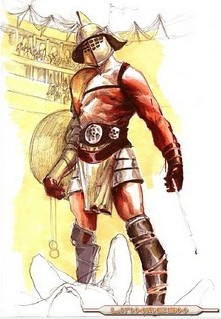
The Provocator’s weapons and armor are very loosely based on that of a Roman legionary. They are by far the best armored warrior for the gladiators.
Weapons
Long Range
Verutum

This Roman javelin would be used to skirmish by Eques before they engaged in hand to hand combat. The verutum is short, a little over a yard long, and very light. Not terrible as far as a javelin goes, but it will struggle to compete with the Apache bow.
The Eques is the only person who will be carrying these, and he’ll have just two.
Mid Range
Fascina/Net

More commonly well known as the trident or harpoon, the fascina is the main weapon of the Retiarius. It provided a good deal of reach, about 5 feet 9 inches for those Americans not inclined to translate the centimeters in the above picture, with about 9 inches of that the metal head. The fascina was designed to match the characterization of the Retiarius as a fisherman, as the trident was the symbol of the Sea God Neptune, and was used for spearing fish. One of the most important aspects of the fascina was the net used with it.

A Retiarius using his net against a Secutor, his traditional opponent.
This circular net could be used to entangle, entrap, or trip an opponent, and Retiarius’s entire style of fighting is built around using this in conjunction with the fascina. It had a pretty wide mesh, and was about 3 yards in diameter. It’s ability to disable opponents is going to make the fascina MUCH more effective.
Hasta

This long spear or lance was a weapon used by many types of gladiators, including the Samnite and Provocator on occasion. The spear was used exclusively for thrusting, it was never thrown. Most used in the gladiatorial arena would be a little shorter than the one pictured above, somewhere around 6 feet in length. This weapon was used for a time by the Roman army, but by the early Empire it was only used rarely by auxiliaries. This won’t necessarily be the primary weapon for the Samnite or the Provocator, they are both armed with effective swords, but the reach and damaging potential of this weapon could cause it to have a large effect on the coming fight.
Short Range
Gladius
This weapon is one of the reasons Rome controlled almost all of Europe, North Africa, and the Middle East during the height of the gladiators. This was the standard weapon of the Roman legionary, and they used this weapon with brutal efficiency and a simple but effective fighting style. The gladius was also one of the defining weapons of the gladiator, common throughout their history and used by several types, including the Samnite and the Provocator. There’s nothing fancy about it, it’s technique is pretty much limited to a stab around the edge of the gladiator’s shield, but history has without a doubt demonstrated its worth as a weapon.
Sica

A Tharaex wielding his weapon of choice. The curve on this weapon would vary, from the more moderate one here to blades approaching 90 degree angles.
This curved short sword is the primary weapon of the Thraex. The sica may not be as efficient as the gladius, but its curved blade has the potential to cause some ugly and devastating injuries. The Thraex was one of the more lightly armored gladiators, so the curved blade of the sica helped level the playing field between him and his more heavily armored foes by stabbing around his opponent’s shields. Another way the weapon was utilized was hooking under his opponents helmets, burying the blade into their chin. With the exception of these two strikes however, the sica is primarily a slashing weapon. Its only real disadvantage is that because of the curve and the slashing style it is used with, the sica is pretty easy to block. This weapon, despite being used by only one type of gladiator, has become one of their most iconic weapons. It was also used in warfare in Thrace and Dacia.
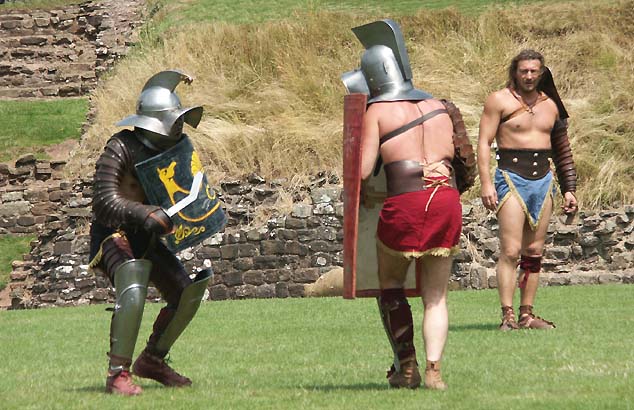
A Thraex, on the left, wielding a sica with a more pronounced curve.
Special Weapon
Spatha

This early on, the Spatha would probably have carried less of a point and been pretty exclusively for slashing.
By beginning of the first century, the Spatha had started to appear in the Roman Empire, mostly wielded by Germanic auxiliaries. This sword was more meaningful in the late Roman Empire, when the influence of Germanic tribes caused the Spatha to replace the gladius not only among the Roman legionaries but in the Gladiatorial arena. The gladiators in this fight are from the the early Imperial Age, so only the Eques, armed as a cavalryman, will be carrying one. The weapon has a lot more reach than the gladius, with about a 30 inch blade.
Pugio
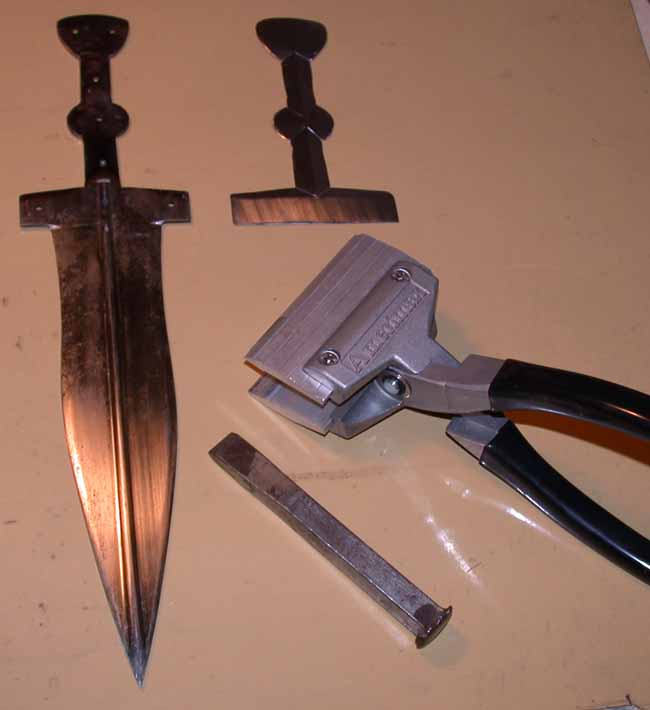
While not a bad dagger by any means, the pugio will not have much of an impact on this fight. Designed primarily for stabbing, the pugio is a pretty effective slasher as well. It is also, unlike the Apache's knives, a weapon of complete last resort for the gladiator, and won't be taken out unless their back is really against the wall. Training with it will also be less than their primary weapons.
Armor
Head
Helmets

While not quite uniform, there are enough similarities between these helmets that I think they can be covered as one group. These helmets are extremely strong, and if they can regularly turn back strikes from iron swords they should have little problem with the weapons the Apache wields. They covered almost the entire head and even most the neck, only leaving a visor for the gladiator to see from and even this usually provided some protection. They were often decorated with crests or plumes. The gladiators were, after all, entertainers first and foremost. Their are some disadvantages however. The helmet is thick, and while this provides phenomenal protection it will slow the gladiator down. Also, peripheral vision, which will be helpful against the ambush loving Apache, will be almost non-existent.
Torso
Gorget
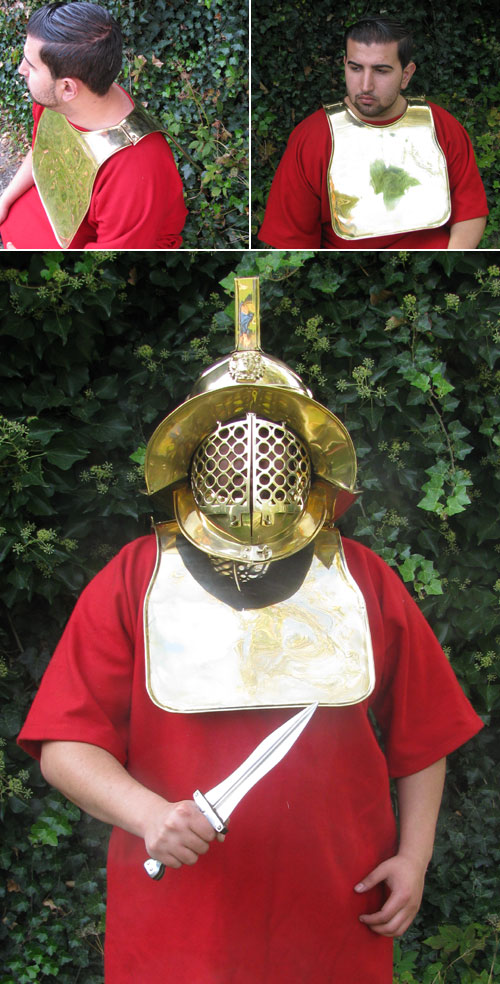
The average gladiator would enter battle completely bare chested, this being considered more impressive and making for quicker, more entertaining matches. One of the few exceptions to this was the Provocator, who wore a bronze gorget to cover their upper chest. While the length seems to vary, and the example here is one of the shorter ones, they seem to usually cut off somewhere around the nipples. It is constructed from brass and again I can't see any of the Apache weapons piercing it. If all five gladiators had this armor, it could drastically effect the fight, but as it stands the effect will be minimal.
Balteus

That thing around his waist
The closest thing to torso armor the rest of the gladiators would have is the balteus, a wide leather sword belt. This was a pretty universal part of gladiator attire, used both to hold swords and daggers and to keep their loincloths on. The bottom line is that it covers a small portion of the gladiator, and doesn't even do a particuarly effective job of that. Minimal benefit if any.
Arms
Manica

This arm and wrist guard first started being used around 0 A.D, and could be constructed from metal, boiled leather, or just heavy padding. They became really commonplace in the arena during the 2nd century. While also used by the Roman army on occasions, most notably against the Dacians, it was mostly associated with the gladiators, to the point where some speculate that it is not shown on most sculptures of Roman soldiers because of its association with the low-class gladiators. It would protect the gladiators sword arm, usually their right one.
Legs
Fascia

The leg binding on these men
The fascia was pretty basic, just padding on the legs of a gladiator. Cloth padding or leather could be used. They covered the legs from the knees down. The Eques and maybe the Retiarius will have this. It's not going to provide great protection, but its better than nothing.
Ocrea

These greaves would be constructed of metal or boiled leather. The Samnite will have one of these on his left leg, and the Tharaex and Provocator will both have two.
It won't let me copy and paste i the imaget, but here is a good picture of a pair of ocrea in good condition.
http://www.flickr.com/photos/40041121@N08/5161994896/
Shields

The symbol would have been different, but otherwise this is pretty much the shield a few of the gladiators will bring to the fight.
While most gladiators carried shields, the form and function of them varied significantly. Most gladiators, including the Provocator and Samnite, will have used a scutum, the standard shield of the Roman army. While a little unwieldly in one on one combat, it covers almost all the gladiators body and is designed to be extremely durable. The Apache will struggle a lot to attack these two head on. The Eques will have a small, round cavalry shield with an iron boss. Pretty helpful for hand to hand combat, and will provide some protection from missiles. Lastly, the Tharaex used the parma, a metal shield, usually round but occasionally square. Decent sized, but not nearly as all encompassing as the scutum.
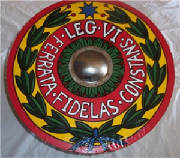
A parma shield
Blocking
The three types of swords can all be used for this, even though only the spatha was really designed with this in mind. The Retiarius will probably be the best at blocking, as the fascina can catch an opponents weapons in its prongs and the net can block pretty much anything the Apache uses. With the exception of the Retiarius however, while these warriors may have weapons that can block effectively, it is simply not a huge part of their fighting style. They can do it if pressed, but the shield is relied on a lot more on defense.
Intangibles
Tactics

The tactics of the Gladiator was defined by the conditions of their battles, one on one. Their weapons were more or less all hand to hand, and they will try to close in and fight in this familiar territory as soon as possible. Even the Eques with his verutum was trained to expend this quickly before beginning the more exciting close quarters combat. When here, most of the gladiators except for the trident wielding Retiarius will close in to the point where the Apache’s mid range, and maybe even close range weapons will be ineffective. The gladius and sica are both short weapons that can be used to stab and need almost no room to maneuver. Roman painting of gladiatorial combat show them getting right in each other’s face, to the point where some of them are clinching like boxers, and this same style of combat will most likely be used here. Specific tactics will vary between types of gladiators, but overall this emphasize on quickly closing in should be consistent, especially considering the unarmored, long range focused warrior they will be fighting. Beyond this though, the gladiator does not have much in the way of tactics. Battles for gladiators were straight up, head to head affairs and this is what they will have prepared for. The gladiator is also used to a type of combat emphasizing entertainment and not usually going for immediate kills, instead injuring and forcing an opponent to submit. This was considered a great skill for a gladiator to have, since a gladiator was a large of investment of money, and some gladiators could force a submission without even inflicting injury.
Teamwork/Cohesion
There will be almost none. While there was a degree of camaraderie between these men who found themselves in the same profession, gladiator combat was almost without exception a solo battle. The gladiators will at best be able to coordinate a few attacks, but there will be no real leadership and no complex maneuvers. Their style of combat has just not prepared them to do this.
Morale
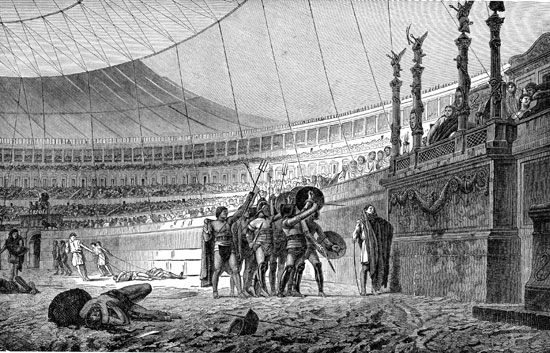
This would vary from warrior to warrior. Gladiators were generally looked down upon in society, and when it came down to it they were slaves. There is a reason Spartacus decided to rise up. On the other hand, they were loved. Citizens of Rome idealized them, and there was a great deal of glory to be hand in victory in the colosseum. They emperor himself would lead their processions before a battle. This difference in opinion was reconciled by focusing on the deeds and ideals of the gladiator, but less the men themselves. This mixed opinion meant the gladiators themselves would have mixed opinions on how ideal their situation was. Some would take joy in combat and glory, but some were very discontented.
Also, the gladiator is used to being in a situation where retreat is not an option, more so than really any other warrior. The flip side of this is that while they could not retreat the gladiator is used to being able to surrender. When he thought he could fight no more, the gladiator would hold up one finger to admit defeat. This, of course, will not happen in this battle. The gladiator will not flee, but he is not used to fighting to the death.
Training
When one began as a gladiator, he would be sent to a special school for training. This were originally run by citizens, but were taken over by the government to prevent private armies from being built up and individuals from becoming too popular. Here it would be determined what weapons he was best suited for, and he would be taught how to use them in the context of a gladiator battle. They were taught not only combat skills but the mindset of being a professional warrior and had extensive physical conditioning. He would be trained by professionals, and constantly assessed by doctors. The training itself would usually only be with wooden mockups of weapons, but these were twice the weight of the real weapon to make things easier when it actually came to combat. The gladiator would be drilled on only his style of fighting. Since actual matches weren’t all that common, training took up a lot of the gladiators life.
Experience

As I’ve said several times, gladiator combat was all one on one, and a gladiator would only ever fight one or two other types of gladiator. While this experience is valuable, it is extremely limited. A gladiator would usually only fight for 3-5 years usually before being freed. A few may have served in the Roman army, or the army of one of Rome’s enemies. Some matches were fought to the death, but these were rare, so experience in a situation where your actually trying to kill your enemy will also be limited.
Physical Traits
The average Roman in the 1st century was about 5 foot 7 inches tall, with obviously some variation. Most gladiators would be about this height, with the exception of some with Gallic or other Celtic origins from the various far reaches of the Empire that could be up to six inches taller. The gladiators themselves would be in great physical condition. They had a good diet, and a lot of their training was just building physical strength and speed. The one area they may be behind most warriors in is endurance, where their matches are incredibly brief when compared to the pitched battles and long campaigns most warriors partake in.
Mobility

This depends on the gladiator. The Provocator was painfully slow, while the Retiarius was known for his quickness in battle, with everyone else falling in between. While some of these faster gladiators like the Retiarius or the Tharaex, may be quick in hand to hand combat or able to close the gap between them and the Apache quickly, there will not be a lot of fancy repositioning or flanking attacks as this is just not how the gladiators approach combat, so even this limited mobility will not be used to its full potential.
Prologue
A Border Settlement in the Cahultecum Yanaguna Province (by modern day El Paso, Texas)

Otho kept his shoulders hunched and his scutum up. He could barely see the eyes of the other man, who was currently peeking over the edge of his shield and had his face covered by his helmets visor. Otho took a deep breath. He had done what he was about to do dozens of times. He slammed his shield forward, sending the other man stumbling back. He kept his footing, but that was all Otho needed was an opening. He stabbed his gladius around the small gap now present around his opponents left leg. His opponent tried to back pedal again. Otho punched at him again with the scutum, and this time his off balance enemy fell to the ground. His opponent tried to bring his gladius up in time to block Otho’s next strike, but he was much too slow. Otho’s sword stabbed down faster than a serpent, and stopped mere inches from the other combatant’s throat. Otho allowed himself a smile, invisible under his helmet. Had this been a true battle, with cold steel instead of the wooden toys, Otho’s enemy would surely be shown little mercy by the crowd for such a brief struggle. As it stood though, the man lying cowed at Otho’s feet had only the minimum of training, just enough to put up a fight. Otho had been fighting ever since he had volunteered five years ago. He would be young by any other professions standards, but at 27 he was as old as any gladiator had business being. He sighed. Turning away from his defeated foe, he pulled his helmet off, wiping his brow with the back of his hand. The helmet was stifling, and the sun of Cahultecum Yanaguna was unrelenting. Otho was not particularly handsome, nor tall, be he carried himself with a certain pride not all in his position did, and the rippling muscles covering his body did much to command respect as well.
Ever since he had crossed the great ocean a year ago, Otho had thought that that it was very fitting that he fought as the Samnite. Just as his career was nearing its end so was his profession. When his owner had sold him to a wealthy aristocrat in the Cahultecum Tanaguna Province, he had been one of the last of his kind left in Rome. Fight organizers had loathed using him, for fear of offending natives of Samnium that were at this point as much a part of the Empire as citizens from the City of Rome. No matter how often he won, and he did win often, he could not become the icon that so many gladiators before him were. He had received a second life here in what was being called the New World, where people in general were rare, let alone Samnites. “Last of a breed” he mumbled as he began walking out of the court.
“Otho!” Trigeminus, another gladiator, came jogging into the other side of the courtyard just then, with an infectious grin plastered on his face. He was wearing a simple tunic and the pants of an Eques, without any weapons or armor. Trigeminus was short, had an ugly scar marring his face, and not the greatest fighter in the arena, but that did not stop him from taking a positive approach toward most things in life. “By Jupiter man, take it easy on poor Balbus.” He said, nodding toward the glorified punching bag only now struggling to his feet. Otho shrugged “If I take it easy on him then he’s not doing his job. I’m only being fair.” Trigeminus chuckled. “A convenient way to look at it, no doubt.” The two men were the only volunteers in the service of Tiberius Avitus Florianus, and had bonded over this, if little else. Their backgrounds were radically different, Otho’s family was poor and he wished to escape his life, and the only reason Trigeminus was fighting was that he was the third and youngest son in his rich family, and was tired of being an afterthought. This still gave them more in common than the criminals and prisoners of war that made up the rest of Florianus’ gladiators. “So you hear the news?” Trigemoinus asked, leaning against a nearby pillar.
“No, what?”
“We’re headed north.”
Otho groaned. He and the other gladiators had been rushed to every corner of Cahultecum Yanaguna to try and give it a reputation an entertaining place to be, somewhere Romans from the increasingly crowded peninsula would be eager to immigrate to. Would this be enough to counteract the lack of infrastructure and hostile tribes to the west as a potential draw to settlers? Otho had his doubts, but he didn’t make policy. “So we all shipping out?” He asked.
“No” Trigemoinus said. “Just a couple. You and me, think we’re bringing the barbarian too. A few others.” Otho allowed himself a smile, if only a small one. “Any new competition for you?” As an Eques, who only fought other Eques, Trigemoinus had some trouble finding opponents in the New World. His smile showed that this wouldn’t be the case here. “I hear he;s fresh off the boat. Should be fun.” Only Trigemoinus would describe what he did as fun. Even the volunteer Otho saw it as a job that he was good at, nothing more, and the prisoners for the most part saw it as what it was for them: a sentence. “When do we leave?” He said, the tiredness he would feel on the trip already manifesting itself in his voice. “Three days.”
“In Pluto's name… and how far?”
He shrugged "We're going to Urbs Scipae... about 30 miles I think." Otho ran his hand over his face. "This isn't close to what I signed up for."
“All in the game, my friend, all in the game. Now if you’ll excuse me.” Trigemoinus said, accompanied with a mock bow, “I want to get some riding in before lunch. See you later.” “See you.” Otho responded glumly.
With a final sigh, Otho trudged inside. At least he wasn’t relocating, only essential possessions would have to be taken. He steeled himself mentally. A few days travel, another fight he knew he could win, and the trip back.
Nothing special.
Hey man, I'm loving this rematch so far!:)
ReplyDeleteI'm still giving it to the Apache though, despite the gladiator's far better armor, I think the Apache has a lot more versatility when it comes to weapons and tactics.
full edges will come tommorow, I am really tired right now. What I have seen looks superb!
ReplyDeleteEdges:
ReplyDeleteLong Range: Dominating Edge Apache
The Javelin's are too limited in quantity, as well as range, skill of users, lethality ect. Essentially the bow is light years ahead here.I guess the Javelin is better then nothing
Mid range:
The Opposite of the previous edge. The Apache spear, while better then nothing, really lacks here in its quality of materials and rarity. Though not every gladiator possesses a mid range, I feel that they are skilled enough to get the edge, as well as having better weapons/weapon combos overall.
Close Range: How many Tomahawks do the Apaches have? Depending on the amount, this edge may change but for now I go with the gladiator for his gladius and sica! While the Tomahawk is effective, the club isn't really.
Special: Knife barely. Though I like the Spatha and the pugio will be great for emergencies, the amount of knives thrown, as well as the accuracy of said knives, will surely help to give them the edge.
Defense:
I am going to save time here and say that the Gladiators pretty much take all categories, though not by much due to their own limited armor in some cases. The Apache's do contest the shield edge, but ultimately I feel that the Gladiators utilize theirs more as they are more close range warriors, as well as possessing better materials, though the Apache's still score some points here, as it suits their greater agility.
Tactics:
A rather large edge to the Apache. While the gladiators are going to be running towards the Apache, I can see the Natives kiting them around, filling them with arrows and ambushing them at every turn. Basically the cost effectiveness mentality of the Apaches prevail here.
Team Cohesion: Apache obviously.
Morale: In my mind this is another Apache edge. They have both a high morale, as well as the ability to accept tactical retreats (meaning they will come back again).
Training: Gladiator takes if for possessing much more.
Experience: This one is so narrow for me that I can't really call it. While the gladiator may have more experience, the apache has superior adaptability, which counts a lot in my book . Ultimately ill go Apache.
Mobility: Apache easily here.
Overall this is a very tough battle for me to judge. The Gladiator takes a contested offensive and dominates defensive, while the Apaches dominate Variables. I wanna go with the Apaches here, but only by the tiniest of margins.
Also I Loved the prologue you had on the Apache side of things, you have already established two big characters in my mind, as well as done a great Apache narrative.
Also you should submit your blog here :
http://www.jayandkirbyproductions.com/forum/post/1720412
Thanks for the edges and prediction, much appreciated!
DeleteAlso thanks for the comment on the Apache prologue, that was my first real foray into narrative writing and I was a little nervous how it would turn out.
And as for the blogger awards, I thought about submitting mine, but I don't think it will be done in time with the pace I'm at and I don't want to slow down the proceedings.
The proceedings are already slow, go ahead and submit!
DeleteAnd i like your prologue alot man, I think you captured the "last of the sammites" portrait well!